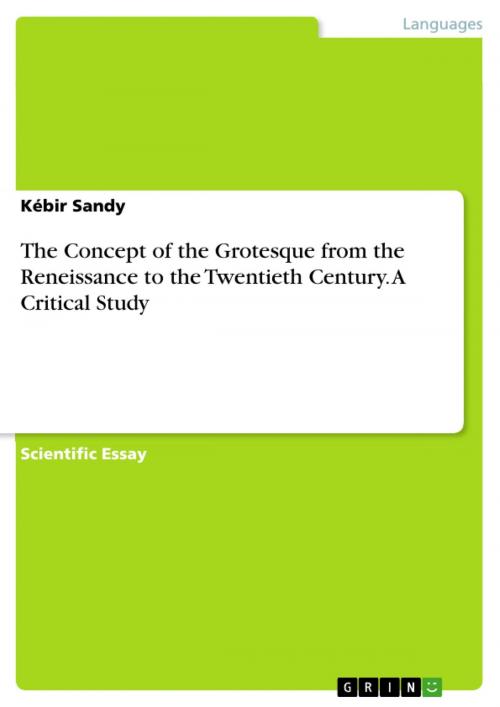The Concept of the Grotesque from the Reneissance to the Twentieth Century. A Critical Study
Fiction & Literature, Literary Theory & Criticism| Author: | Kébir Sandy | ISBN: | 9783668201767 |
| Publisher: | GRIN Verlag | Publication: | April 21, 2016 |
| Imprint: | GRIN Verlag | Language: | English |
| Author: | Kébir Sandy |
| ISBN: | 9783668201767 |
| Publisher: | GRIN Verlag |
| Publication: | April 21, 2016 |
| Imprint: | GRIN Verlag |
| Language: | English |
Scientific Essay from the year 2015 in the subject Literature - Basics, , language: English, abstract: A good understanding of the grotesque necessitates not only an account of the historical development of the word 'grotesque' and its usage, but also the various concepts with which it has often been associated, and the different theories and opinions expressed about it. We begin, first of all, by giving a brief examination of the history of the term, its origin, derivation, and semantic evolution. It is widely agreed that the word 'grotesque originated to describe the murals which were discovered, in the course of excavation, beneath the baths of Titus in Rome at the end of the 15th century'. These paintings present a style of art which was completely unknown at the time. It is mainly characterized by its heterogeneous nature; it combines many different and ambivalent elements: human, animal, and vegetable. In English the word 'grotesque' was introduced around 1640 to replace other previous forms, which came either from the Italian, like grotesco or crotesco, or the French like, crotesque. In fact, according to the O.E.D. the French form was the first to be recorded in the language. In French, crotesque occurred in 1532 and continued to prevail until the end of the 17th century. As early as the 16th century, the word 'grotesque extended in French to non artistic things and literature. In his Essai, Montaigne wrote: 'Que sont ce icy aussi (Les Essais) a la vérité que crotesques et corps monstrueux'. And Rabelais used it to refer to parts of the body in 'Gargantua et Pantagruel' (1535), ('Couillon crotesque'). From the late 17th century, the word as an adjective knew a large usage. But in both England and Germany, it remained restricted to its early original usage until the 18th century when it got a wide application. It was associated with caricature which provoked too much emphasis on the ridiculous and a neglect of the terrible and terrifying side of the grotesque.
Scientific Essay from the year 2015 in the subject Literature - Basics, , language: English, abstract: A good understanding of the grotesque necessitates not only an account of the historical development of the word 'grotesque' and its usage, but also the various concepts with which it has often been associated, and the different theories and opinions expressed about it. We begin, first of all, by giving a brief examination of the history of the term, its origin, derivation, and semantic evolution. It is widely agreed that the word 'grotesque originated to describe the murals which were discovered, in the course of excavation, beneath the baths of Titus in Rome at the end of the 15th century'. These paintings present a style of art which was completely unknown at the time. It is mainly characterized by its heterogeneous nature; it combines many different and ambivalent elements: human, animal, and vegetable. In English the word 'grotesque' was introduced around 1640 to replace other previous forms, which came either from the Italian, like grotesco or crotesco, or the French like, crotesque. In fact, according to the O.E.D. the French form was the first to be recorded in the language. In French, crotesque occurred in 1532 and continued to prevail until the end of the 17th century. As early as the 16th century, the word 'grotesque extended in French to non artistic things and literature. In his Essai, Montaigne wrote: 'Que sont ce icy aussi (Les Essais) a la vérité que crotesques et corps monstrueux'. And Rabelais used it to refer to parts of the body in 'Gargantua et Pantagruel' (1535), ('Couillon crotesque'). From the late 17th century, the word as an adjective knew a large usage. But in both England and Germany, it remained restricted to its early original usage until the 18th century when it got a wide application. It was associated with caricature which provoked too much emphasis on the ridiculous and a neglect of the terrible and terrifying side of the grotesque.















